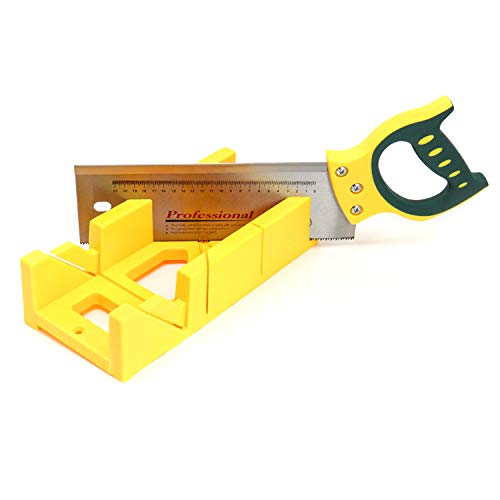Single-bevel miter saws have blades that can rotate to the left and right, but cannot be adjusted to cut at an angle. Dual-bevel miter saws can rotate to the left and right, and can also tilt the blade to the left and right to make angled cuts.
If you’re looking to get into woodworking, a miter saw is a must-have tool. But did you know that there are two types of miter saws – single-bevel and dual-bevel? They both do the same job but the differences between them can affect how you use them in your woodworking projects.
In this blog, we’ll discuss the basics of single-bevel and dual-bevel miter saws, and the differences between them. We’ll talk about design differences, accuracy and precision, versatility, cost considerations, and maintenance and care. By understanding the differences, you can make an informed decision about which miter saw is best for you and your woodworking projects.
Basic overview of single-bevel and dual-bevel miter saws
Miter saws are a popular tool used in woodworking projects, and they come in two varieties: single-bevel and dual-bevel. So what is the difference between these two types of saws?
Single-bevel saws are a great choice for basic cutting needs, as they can only tilt one direction. This makes them great for simple projects like cutting baseboard and crown molding. On the other hand, dual-bevel saws are perfect for more complex projects, as they can tilt the blade in both directions. This allows for more versatility and accuracy when making angled cuts.
Single-bevel saws usually have a smaller blade than dual-bevel saws, which makes them more portable and easier to store. They are also typically less expensive than dual-bevel saws. On the other hand, dual-bevel saws have a larger blade, which allows for more power and precision. They are also more expensive than single-bevel saws.
No matter which type of saw you choose, both single-bevel and dual-bevel saws can be great tools for any woodworking project. With the right knowledge and skills, you can make excellent cuts with either one. So if you’re looking to get into woodworking, take a look at both saws and decide which one is right for you.
Differences in design
When it comes to miter saws, there are two main types to choose from: single-bevel and dual-bevel. While both saws are built for the same purpose, there are some key differences that can affect the type of projects you’re able to make.
The biggest difference between the two is the beveling capability. Single-bevel miter saws only bevel on one side, usually the left, while dual-bevel miter saws bevel on both sides. This makes the dual-bevel miter saw the more versatile option, as it can cut both left and right bevels, making it easier to work with complex angles. It’s also great for making miter cuts with minimal setup time.
Another difference between the two is the size. Single-bevel miter saws tend to be smaller and more lightweight than dual-bevel miter saws, making them easier to transport and store. This makes them the better choice for hobbyists or someone who needs to move their saw from place to place.
Finally, single-bevel miter saws tend to be cheaper than dual-bevel miter saws, making them a more budget-friendly option. If you’re on a tight budget and don’t need the extra features of a dual-bevel miter saw, then a single-bevel miter saw may be the right choice for you.
In conclusion, the main differences between single-bevel and dual-bevel miter saws are in their beveling capabilities, size, and price. Depending on your needs, one type may be better suited to your project than the other.
Accuracy and precision
When it comes to precision sawing with a miter saw, accuracy and precision are both key. The accuracy of your cuts and the precision of the angles you create both have a direct impact on the quality of your project. With single-bevel and dual-bevel miter saws, you can tailor your sawing experience to maximize accuracy and precision.
Single-bevel miter saws feature a blade that is fixed in place and is only able to pivot to one side. This makes them ideal for making precise, accurate cuts at a variety of angles. They’re particularly useful for creating intricate mitered corners, as the blade can be repositioned easily for detailed work.
Dual-bevel miter saws, on the other hand, feature a blade that is able to pivot to both sides. This allows you to make more precise cuts with more angles as you can adjust the blade to make slight adjustments in either direction. This makes them perfect for creating complex projects that require a greater level of accuracy and precision.
In the end, it’s up to you to decide which type of miter saw is best for your unique project. Both single-bevel and dual-bevel miter saws offer an impressive level of accuracy and precision, so you can rest assured that whichever saw you choose, you’ll be able to create beautiful, high-quality cuts.
Versatility and flexibility
When it comes to versatility and flexibility, single-bevel and dual-bevel miter saws offer different advantages. For starters, single-bevel saws are able to cut in one direction only, but are much simpler to use and maintain. In addition, they are often more affordable and can be more portable for those who need to take them on the go. Dual-bevel saws, on the other hand, offer much more versatility. By being able to cut in both directions, they can tackle a wider range of projects. They also offer more precision and accuracy, making them perfect for more detailed projects.
No matter which type of saw you choose, they both offer the same convenience of being able to make angled cuts quickly and easily. Some single-bevel saws even come with additional features like laser guides that make it easier to line up your cuts. With a dual-bevel saw, you can also make compound cuts, which make it even easier to achieve the exact angles you need.
In the end, it really just comes down to what you need. If you’re looking for a saw that is simple and easy to use, then a single-bevel saw might be the best option. On the other hand, if you’re looking for a saw that offers more versatility and flexibility, then a dual-bevel saw is the way to go. No matter what you choose, both types of saws offer plenty of versatility and flexibility to make all your projects easier.
Cost considerations
When looking at the differences between single-bevel and dual-bevel miter saws, cost is an important factor to consider. Single-bevel saws are typically the more economical option, coming in at a lower price point than dual-bevel saws. However, if you are looking for something that can offer more precision and accuracy, then you’ll want to go with a dual-bevel saw.
Dual-bevel saws may have a higher price tag, but they offer a lot in terms of capabilities. They are able to provide much finer cuts than single-bevel saws, allowing for precision when working on projects that require intricate details. They are also great for complex cutting tasks, such as making angled cuts or cutting compound miters.
Another cost consideration is that dual-bevel saws require more maintenance than single-bevel saws. Dual-bevel saws need to be adjusted periodically to ensure that they are cutting at the right angle. Single-bevel saws, on the other hand, don’t require much maintenance and are usually good to go right out of the box.
Overall, you will want to factor in cost when deciding between a single-bevel and dual-bevel miter saw. While dual-bevel saws may have a higher price tag, they offer more precision and accuracy and are great for tasks that require intricate details. Single-bevel saws are the more economical option, but require less maintenance and are ready to use right out of the box.
Maintenance and care
Maintaining and caring for your miter saw is an important part of owning a tool of this caliber. Whether you own a single-bevel or dual-bevel miter saw, proper maintenance and care can ensure that your saw operates safely and efficiently.
For single-bevel miter saws, special attention should be paid to the saw blade. After each use, the blade should be inspected for damage, such as chips or cracks. If any damage is found, the blade should be replaced immediately, as it can cause serious injury if used. Regularly cleaning the blade, as well as the saw’s other components, can keep it in proper working order.
Dual-bevel miter saws require similar maintenance and care. It is important to ensure that the blade is clean and free of debris, as this could potentially cause damage to the saw’s internal components. Additionally, dual-bevel miter saws often have additional features, such as laser cut lines or a digital display, which should be inspected regularly to make sure they are functioning properly.
Finally, both single-bevel and dual-bevel miter saws should be lubricated regularly to ensure that the internal components are running smoothly. This can help to prevent damage caused by friction and heat, and can also extend the life of your saw.
By taking proper care of your miter saw, you can rest assured that your saw will be safe and reliable for years to come.

Frequently Asked Questions
What makes single-bevel and dual-bevel miter saws different?
Single-bevel miter saws are designed to cut material at a single angle while dual-bevel miter saws can cut it at two angles. Single-bevel saws require the user to flip the material or move the saw to cut at different angles, while dual-bevel saws allow the user to quickly and easily switch the angle of the blade. Additionally, dual-bevel saws are able to bevel both left and right, while single-bevel saws are limited to only one direction.
Which type of miter saw offers more accuracy and precision?
Dual-bevel miter saws are more accurate and precise compared to single-bevel miter saws. This type of saw can be adjusted to both right and left angles, allowing for a greater degree of accuracy. The cutting blade also tilts in both directions, allowing you to make precise and intricate cuts. Dual-bevel miter saws also feature more advanced features like laser guides and digital readouts, which help you to make more precise cuts.
What are the pros and cons of each type of miter saw?
The pros and cons of single-bevel and dual-bevel miter saws depend on your specific project needs. Single-bevel saws are easier to use and tend to be more affordable, but are limited to making one angle cut. Dual-bevel saws offer greater flexibility and can cut both left and right angles, but they tend to be more expensive.
Is one type of miter saw better for specific kinds of projects?
Yes, one type of miter saw is often better for specific projects. Single-bevel miter saws are more suitable for simple, straightforward cuts that don’t require intricate angles. Dual-bevel miter saws are better for complex cuts that require making angled cuts in both directions, as they allow you to tilt the blade to a precise angle.
Conclusion
Overall, single-bevel and dual-bevel miter saws have their own strengths and weaknesses. Single-bevel is the more traditional type of saw and is great for sizing and trimming wood. On the other hand, the dual-bevel is a newer saw that is more convenient and efficient. It is great for joint and molding work, as it can cut in both directions. Both saws are reliable and have their own advantages. When it comes to choosing the right miter saw for your project, you should consider your needs and budget. Choose the saw that best suits your needs and you’re sure to achieve your desired results.
